Trichoderma atroviride PHR1, a fungal photolyase responsible for DNA repair, autoregulates its own photoinduction
- PMID: 17545314
- PMCID: PMC2043357
- DOI: 10.1128/EC.00208-06
Trichoderma atroviride PHR1, a fungal photolyase responsible for DNA repair, autoregulates its own photoinduction
Abstract
The photolyases, DNA repair enzymes that use visible and long-wavelength UV light to repair cyclobutane pyrimidine dimers (CPDs) created by short-wavelength UV, belong to the larger photolyase-cryptochrome gene family. Cryptochromes (UVA-blue light photoreceptors) lack repair activity, and sensory and regulatory roles have been defined for them in plants and animals. Evolutionary considerations indicate that cryptochromes diverged from CPD photolyases before the emergence of eukaryotes. In prokaryotes and lower eukaryotes, some photolyases might have photosensory functions. phr1 codes for a class I CPD photolyase in Trichoderma atroviride. phr1 is rapidly induced by blue and UVA light, and its photoinduction requires functional blue light regulator (BLR) proteins, which are White Collar homologs in Trichoderma. Here we show that deletion of phr1 abolished photoreactivation of UVC (200 to 280 nm)-inhibited spores and thus that PHR1 is the main component of the photorepair system. The 2-kb 5' upstream region of phr1, with putative light-regulated elements, confers blue light regulation on a reporter gene. To assess phr1 photosensory function, fluence response curves of this light-regulated promoter were tested in null mutant (Deltaphr1) strains. Photoinduction of the phr1 promoter in Deltaphr1 strains was >5-fold more sensitive to light than that in the wild type, whereas in PHR1-overexpressing lines the sensitivity to light increased about 2-fold. Our data suggest that PHR1 may regulate its expression in a light-dependent manner, perhaps through negative modulation of the BLR proteins. This is the first evidence for a regulatory role of photolyase, a role usually attributed to cryptochromes.
Figures


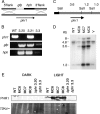
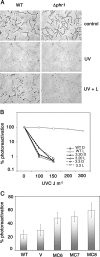
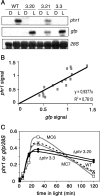
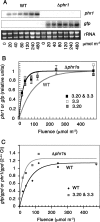
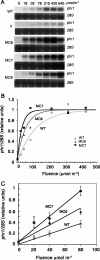
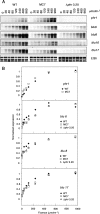


Similar articles
-
The Trichoderma atroviride photolyase-encoding gene is transcriptionally regulated by non-canonical light response elements.FEBS J. 2013 Aug;280(15):3697-708. doi: 10.1111/febs.12362. Epub 2013 Jun 27. FEBS J. 2013. PMID: 23721733
-
Two Photolyases Repair Distinct DNA Lesions and Reactivate UVB-Inactivated Conidia of an Insect Mycopathogen under Visible Light.Appl Environ Microbiol. 2019 Feb 6;85(4):e02459-18. doi: 10.1128/AEM.02459-18. Print 2019 Feb 15. Appl Environ Microbiol. 2019. PMID: 30552186 Free PMC article.
-
Rapid blue light regulation of a Trichoderma harzianum photolyase gene.J Biol Chem. 1999 May 14;274(20):14288-94. doi: 10.1074/jbc.274.20.14288. J Biol Chem. 1999. PMID: 10318850
-
Photolyase/cryptochrome blue-light photoreceptors use photon energy to repair DNA and reset the circadian clock.Oncogene. 2002 Dec 16;21(58):9043-56. doi: 10.1038/sj.onc.1205958. Oncogene. 2002. PMID: 12483519 Review.
-
Photolyases: capturing the light to battle skin cancer.Future Oncol. 2006 Apr;2(2):191-9. doi: 10.2217/14796694.2.2.191. Future Oncol. 2006. PMID: 16563088 Review.
Cited by
-
More than a repair enzyme: Aspergillus nidulans photolyase-like CryA is a regulator of sexual development.Mol Biol Cell. 2008 Aug;19(8):3254-62. doi: 10.1091/mbc.e08-01-0061. Epub 2008 May 21. Mol Biol Cell. 2008. PMID: 18495868 Free PMC article.
-
The Genomes of Three Uneven Siblings: Footprints of the Lifestyles of Three Trichoderma Species.Microbiol Mol Biol Rev. 2016 Feb 10;80(1):205-327. doi: 10.1128/MMBR.00040-15. Print 2016 Mar. Microbiol Mol Biol Rev. 2016. PMID: 26864432 Free PMC article. Review.
-
Fungal cryptochrome with DNA repair activity reveals an early stage in cryptochrome evolution.Proc Natl Acad Sci U S A. 2015 Dec 8;112(49):15130-5. doi: 10.1073/pnas.1514637112. Epub 2015 Nov 17. Proc Natl Acad Sci U S A. 2015. PMID: 26578805 Free PMC article.
-
The Photoreceptor Components FaWC1 and FaWC2 of Fusarium asiaticum Cooperatively Regulate Light Responses but Play Independent Roles in Virulence Expression.Microorganisms. 2020 Mar 5;8(3):365. doi: 10.3390/microorganisms8030365. Microorganisms. 2020. PMID: 32150839 Free PMC article.
-
Light-dependent functions of the Fusarium fujikuroi CryD DASH cryptochrome in development and secondary metabolism.Appl Environ Microbiol. 2013 Apr;79(8):2777-88. doi: 10.1128/AEM.03110-12. Epub 2013 Feb 15. Appl Environ Microbiol. 2013. PMID: 23417004 Free PMC article.
References
-
- Ahmad, M., and A. R. Cashmore. 1993. HY4 gene of A. thaliana encodes a protein with characteristics of a blue-light photoreceptor. Nature 366:162-166. - PubMed
-
- Alejandre-Duran, E., T. Roldan-Arjona, R. R. Ariza, and M. RuizRubio. 2003. The photolyase gene from the plant pathogen Fusarium oxyosporum f. sp. lycopersici is induced by visible light and α-tomatine from tomato plant. Fungal Genet. Biol. 40:159-165. - PubMed
-
- Berrocal-Tito, G., T. Rosales-Saavedra, A. Herrera-Estrella, and B. Horwitz. 2000. Characterization of blue-light and developmental regulation of the photolyase gene phr1 in Trichoderma harzianum. Photochem. Photobiol. 71:662-668. - PubMed
-
- Berrocal-Tito, G., L. Sametz-Baron, K. Eichenberg, B. A. Horwitz, and A. Herrera-Estrella. 1999. Rapid light regulation of a Trichoderma harzianum DNA photolyase gene. J. Biol. Chem. 274:14288-14294. - PubMed
Publication types
MeSH terms
Substances
LinkOut - more resources
Full Text Sources
Molecular Biology Databases

